
Andalucia, a paradise full of wonders
Andalucia is a jewel of nature where different types of vegetation and landscapes coexist, making it unique in Spain. In this community you can enjoy many of the universal aspects of tourism, since Andalucia is a melting pot of places full of magic and monuments brimming with history that are sustained by centuries of cultural fusion.
Cliffs, dreamy beaches, peculiar mountain ranges and a great deal more make up its huge legacy. In Andalucia, thanks to the huge diversity in its climate and natural environments, each of the provinces that make up the community is an entire universe of unique and special spaces that you will not forget.
Do you want to get to know the most special wonders of Andalucia? Here is a selection of natural environments that you cannot miss. Let’s dive together into the exciting ecosystems of southern Europe.
1. Doñana (Huelva, Seville and Cádiz)
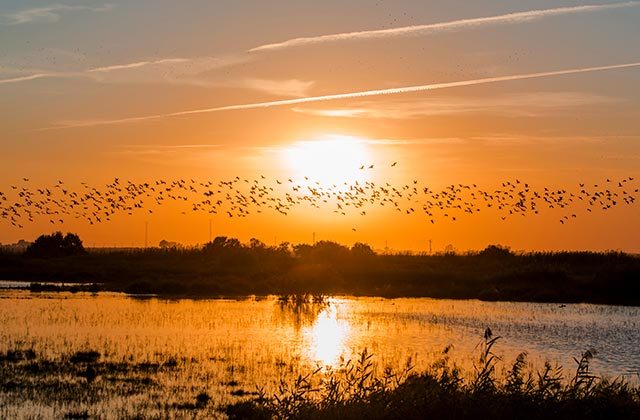
Parque Natural de Doñana
The Doñana National Park stands in the heart of three Andalucian provinces: Huelva, Cádiz and Seville. In this area you can see over 300 different species of birds a year, as it is a transit, breeding and wintering ground for thousands of them, some from other parts of Europe and some from Africa. It is considered Europe’s largest ecological reserve and its fauna include the booted eagle, imperial eagle, marsh harrier, mallard, crested coot, crane, duck, mongoose, azure-winged magpie, buzzard, loggerhead and magpie, among others, with the Iberian lynx being the stand-out option. All these animals live in an idyllic natural environment among oaks, eucalyptus and pinyon pines. If you came to this place you can find the perfect image of Doñana in the marshes: flamingos perched on the waters and in breath-taking flight, so don’t forget your camera.
2. La Breña y Marismas de Barbate (Cádiz)
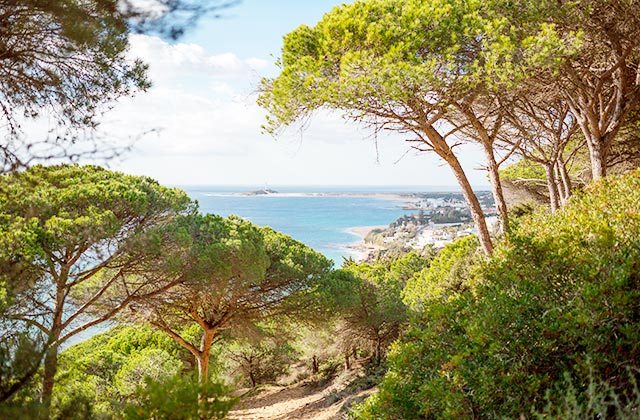
La Breña y Marismas de Barbate (Cádiz)
From the environment of Barbate to the Caños de Meca and inland to Vejer de la Frontera lies the small La Breña y Marismas del Barbate Natural Park. Despite its small size, five different ecosystems can be distinguished. The cliffs, the pine trees, the marimas and the dunes are some of the most unique attractions in this environment. If you came here, make sure you take a boat trip along the coast from the port of Barbate to enjoy the fresh air and the ocean breeze. If what you like is sports, scuba diving is one of the most common practices in this area where you can admire not only the beauty of the area, but also the seabed. A unique experience that you will keep forever and unforgettable memories of one of the places worthy of becoming an Andalucian natural wonder.
3. Tabernas desert (Almería)
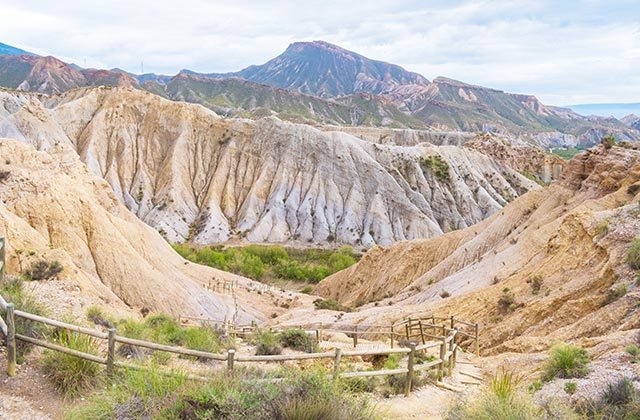
Desierto de Tabernas (Almería)
Just like in westerns, the desert of Tabernas in Almería stands in the middle of Andalucia. This place is characterised by a set of gullies crossed by torrential rivers in the desert which only carry water, mud and stones during floods. It is considered the only proper desert area in the European continent and provides extremely impressive and breath-taking scenery. If you’ve never visited this place, make sure you do it. It looks completely different from the typical Andalucian scenery.
4. Sierra Nevada (Granada)
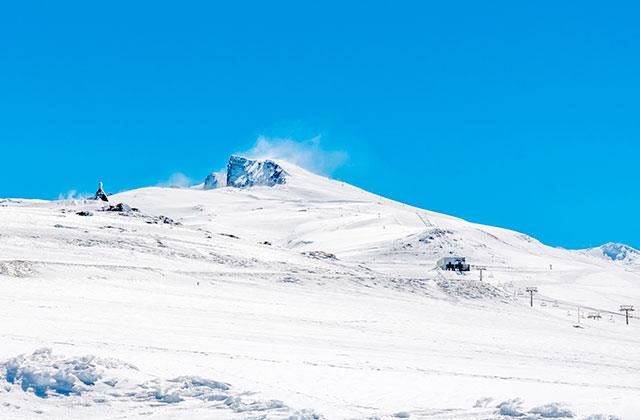
Sierra Nevada, Pico Veleta
A snow-white spot par excellence in the heart of Andalucia, Sierra Nevada, nestled in the beautiful city of Granada, is one of the Andalucian spots worthy of becoming a natural wonder. In the mountains, such as in the Veleta or the Tajo de los Machos, between natural rock crevices, you can find unique species like the Sierra Nevada violet or the plantago nivalis. At this altitude, glacial valleys can also be found such as the Siete Lagunas (Seven Lagoons), while lower down, deciduous forests consisting of oak trees, maple, cherry and chestnut dominate. As well as these amazing plants, there is impressive fauna, such as the wild boar, fox, badger and the genet. This setting is ideal if you like skiing, so come to Sierra Nevada to enjoy the sights and the sport.
5. El Torcal, Antequera (Málaga)
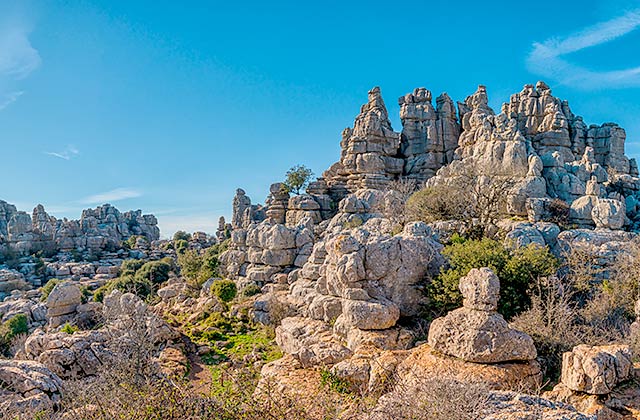
El Torcal Antequera, Malaga
One of the natural wonders of Andalucía is located in Antequera, specifically in El Torcal, one of the most significant examples of karst landscape in Spain. In El Torcal, limestone rocks have been modelling themselves over the years and adapting curious shapes which would stand out in any other landscape. Its seabed origin has meant that there are numerous invaluable prehistoric fossils here. Its mushroom-shaped rock formations and its most famous rock, “the screw”, create a remarkable view where, in addition to the unusual landscape, you can go stargazing at its observatory and on various organised routes. An unmissable place if you are curious and which you will fully enjoy thanks to its beauty and its natural wealth.
6. Caminito del Rey and Desfiladero de los Gaitanes (Málaga)
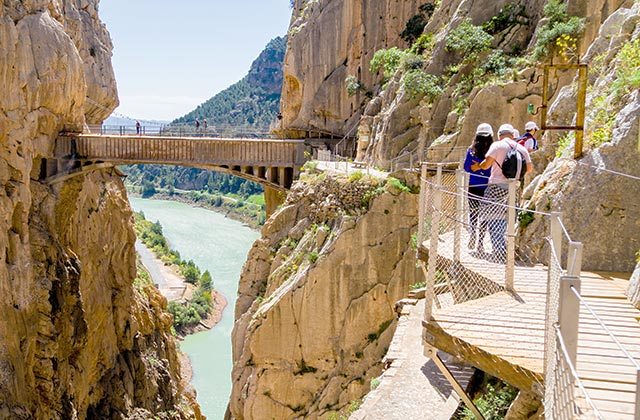
Caminito del Rey y Desfiladero de los Gaitanes (Málaga)
In the natural setting of El Chorro in the province of Málaga is the Caminito del Rey, immersed in Desfiladero de los Gaitanes. This is a three-kilometre long and one-metre wide pass hanging up to 100 metres above the river, in the almost vertical walls of the cliff. A complete and utter defiance of vertigo in a huge limestone gorge that stands on the Guadalhorce river and which gives an eagle-eyed view to those who dare to approach. Nature and fresh air at a height from which you can see the beauty of the place and enjoy this unique landscape.
7. Río Tinto (Huelva)
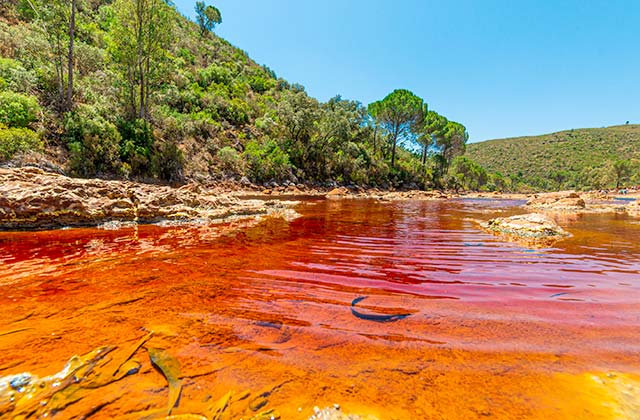
Rio Tinto Huelva
Río Tinto (Red River) is known for the reddish colour of its waters, hence its name. The colour stems from the weathering of sulphide minerals containing heavy metals found in the deposits along its course. The result is a place without equal in the world, witnessed to the mining past of this province. Come to this natural wonder and challenge your view with optical illusions as whirlpools of fire are generated naturally. This wonder excels in originality and has become one of the mandatory visits in Huelva and where your camera will be especially important, since there are few landscapes like this in the world. The great diversity of micro-organisms adapted to extreme habitats has led NASA to conduct studies on the area, focused on parallels with the planet Mars.
8. Bolonia beach, Tarifa (Cádiz)
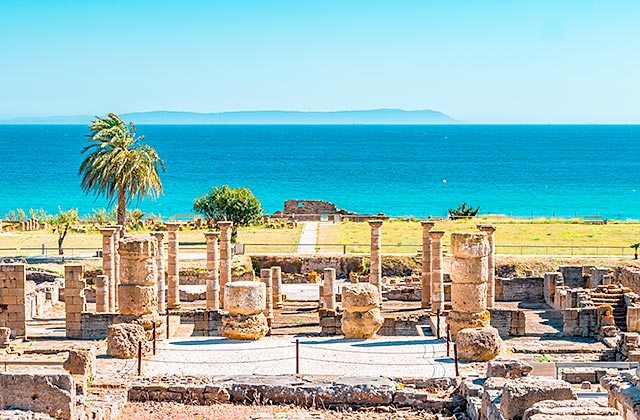
Baelo Claudia, Bolonia
The beach at Bolonia in Tarifa is one of the last unspoiled beaches in southern Europe. The fine golden sand dunes are one of the most impressive natural wonders of the place. Near the beach are the ruins of the ancient Roman city of Baelo Claudia, in excellent condition. Its crystal clear waters let you see the seabed and it is one of the most important seafaring areas in Andalucia. Its environmental beauty and the sense of peace that it transmits are two factors that make it a strong candidate for an Andalucian natural wonder. If you have not yet visited this area on the Cádiz coast, feel free to do so and enjoy the sunset.
9. Parque Natural Sierra de Grazalema (Cádiz and Málaga)
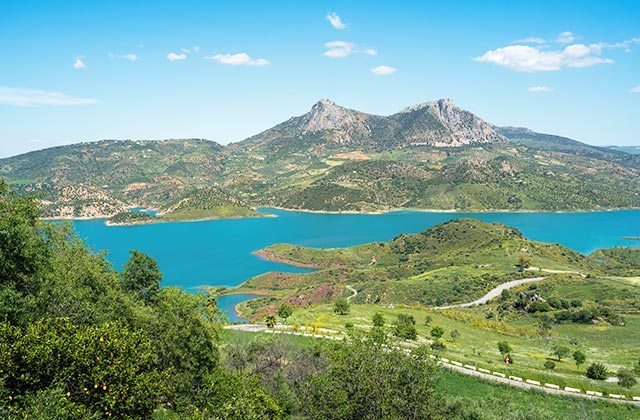
Parque Natural Sierra de Grazalema
Between the provinces of Cádiz and Málaga is the Sierra de Grazalema. There is no better option for clearing your lungs out with fresh air. If you come here, you can enjoy the dense Mediterranean forest filled with oak, cork and gall trees as well as its most characteristic species, the Spanish fir. Mainly concentrated in the Sierra del Pinar, as it is the wettest place in the Peninsula, this species descends from the Central European spruce trees which formed huge forests here during the ice ages. Today, these firs only live in this area, in the Sierra de las Nieves National Park and in Sierra Bermeja (both in the province of Málaga), hence its uniqueness. The natural value of this environment is huge in addition to the added value provided for visitors when seeing it up close, doing activities like hiking or seeing a vast array of different birds.
10. Sierra de Cazorla, Segura and Las Villas (Jaén)
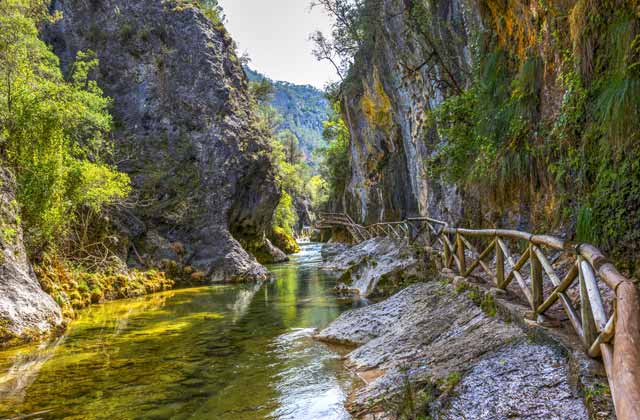
Sierra de Cazorla, Jaén
The Sierra de Cazorla is one of the most visited in Spain. Its natural wealth is based on biodiversity and is considered a Biosphere Reserve by UNESCO. Located in the province of Jaén, here we can find the largest expanse of pine forest in Spain, with four of the six Iberian species represented. Its fauna is rich and varied, with the deer, ibex and wild boar standing out, as well as important populations of bighorn sheep and fallow deer. An ideal location if you’re looking to relax with your family in the midst of nature and a strong candidate to become one of the natural wonders of Andalucia.
11. The Strait (Cadiz)
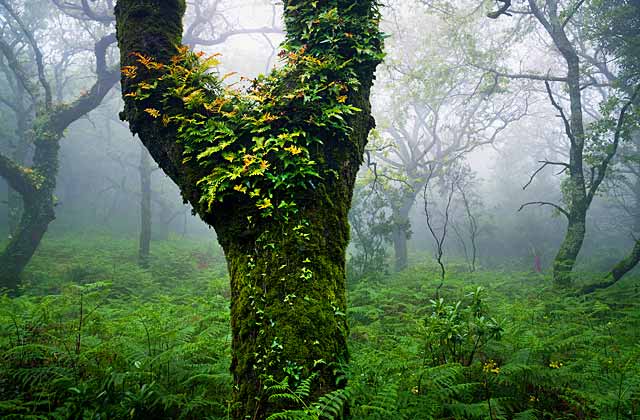
El Estrecho, Cádiz
Declared Natural Park in 2003. It has an extension of around 19,000 hectares. It is located in the southern end of the province of Cadiz, between the municipal terms of Algeciras and Tarifa. Includes a strip of land parallel to the coast. We can highlight the Sierras de la Plata, Betis and San Bartolomé.
The Strait is an exceptional venue of the relations between Europe and Africa and an important transit route between the Mediterranean and the Atlantic. The flora is varied: pines, eucalyptus, olive trees, savin junipers and junipers. Inland we find the mastic and the bayon. Are endemic to the area: the narcissus veridiflorus, the genista and the juniperus.
The marine fauna is varied, with protected species. Stand out as protected species: the loggerhead turtle, the leatherback turtle and the hawksbill turtle. There are megalithic remains such as the Dolmen de las Piñas. As historic remains, we can highlight the Roman ruins of Baelo Claudia (designated National Historic Monument) and the Lighthouse of Tarifa. Along the coast there are a set of towers that were used for surveillance. Inland, caves with remains of art rock have also been discovered.
The Castle of Tarifa is historically famous due to the episode of Guzmán el Bueno. At the Strait, we find remains of sunken ships, called “wrecks”. Occasionally, they have suffered illegal extractions.
12. Los Alcornocales natural park
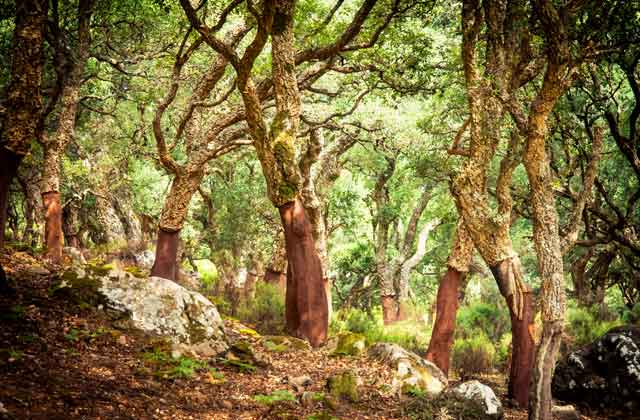
Los Alcornocales, Càdiz
Located between the provinces of Cadiz and Malaga and with more than 170,000 hectares, the Los Alcornocales Natural Park is formed by a succession of steep mountains of different heights, where several caverns and caves exist.
The wet winds that arrive from the sea and the frequent rains, make of Los Alcornocales Park Natural, one of the most extraordinary wonders of Andalucia. You must visit it and enter its cork forests, go down its “canutos” and ravines until reaching its rivers and streams where only the sunlight makes a visit, and surround yourself with the subtropical forest called laurisilva where the strawberry tree, hazel, or laurel among many other, grow so wild and lush, leaving any hiker speechless.
The roe deer called “Moorish” has here the last stronghold in Andalucia and we can also find genets, deer, mountain goats, or the otter, which also have here their natural habitat.
As for sports, mountaineering, climbing, fishing or hiking among many other alternatives are asked for in this wonderful Natural Park.
13. Sierra de Hornachuelos natural park
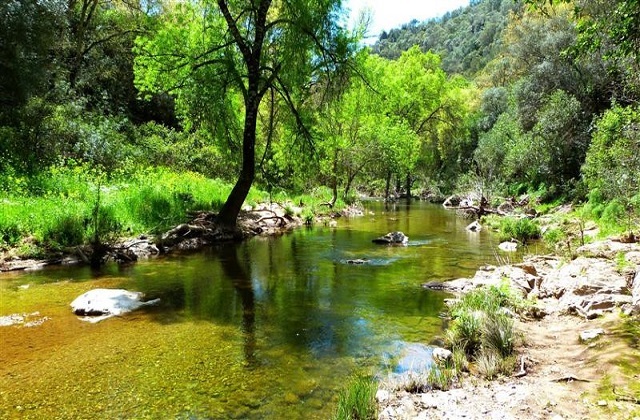
Sierra de Hornachuelos
This beautiful Park can be found to the West of the province of Córdoba. With an extension of more than 60,000 hectares, has one of the best preserved wooded areas of Sierra Morena, being the oak its dominant species.
When visiting the Sierra de Hornachuelos, you can see that there are deep ravines sculpted by the rivers that pass by the area, as is the case of the Guadiato or the Bembezar, meadows where the Iberian pig lives, or spot the Peña del Fraile, images that will embrace you in a magic atmosphere as you walk by the multiple trails that surround the area. Also, is highly recommended to visit the near villages to taste the traditional mountain delicacies. Thus, in Posadas, Hornachuelos, Almodovar del Río among others, you can enjoy sausages or game meat, or honey collected from the place.
We must visit before leaving the Natural Park, the village of San Calixto in the heart of the Sierra and admire its somewhat really admirable architectural ensemble.
14. Sierra de Aracena natural park and the peaks of Aroche
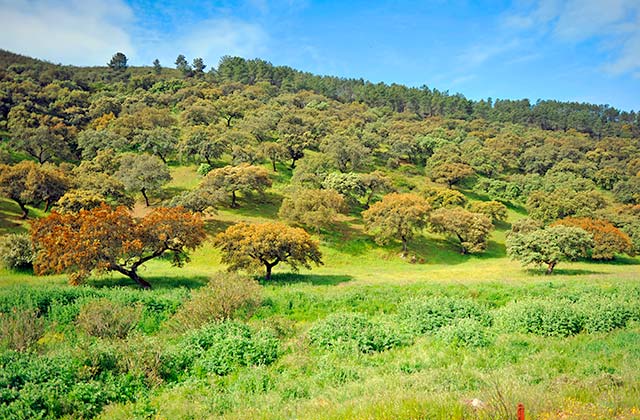
Sierra de Aracena natural park
It is characterized by its dense forest, and a mild climate with high rainfall. It has a surface of more than 186,000 hectares and is located in the province of Huelva.
The cultural and natural heritage of this park will arouse the curiosity and the interest of everyone who contemplates its meadows of oaks and cork, chestnut forests and riverside woods. Of course, you must not forget to taste its cuisine as the Iberian pig products are outstanding, like the Acorn Iberian ham, the goat cheeses, the chestnuts, mushrooms or the game meat.
Unavoidable for every traveler, not passing by its villages and enjoy its heritage. Almonaster la Real with its castle, Church and mosque, Cortegana and its magnificent Castle, or the town of Cumbres Mayores. If to all these places, you add the visit to the Grotto of the Marvels in Aracena, we can consider that our visit to the Sierra of Aracena Park Natural and the Peaks of Aroche has been a success.
15. Sierra Norte de Sevilla natural park
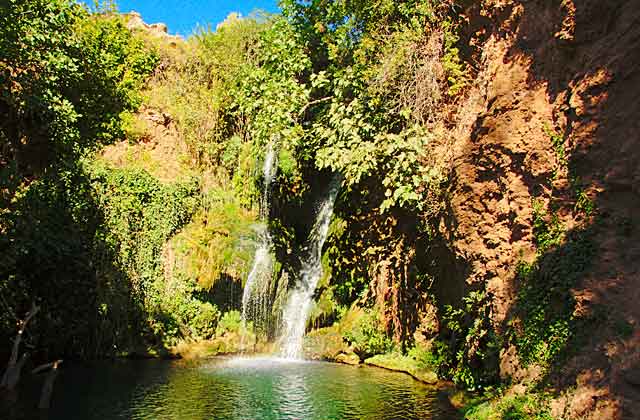
Sierra Norte, Sevilla
Located to the North of the province of Seville, it has more than 177,000 hectares, having an essential role in logging and livestock farms.
It has the curious fact for fishing enthusiasts of being the only trout River in Sierra Morena. We also find here one of the many natural monuments, the Cascadas del Huesna, created by the water rich in carbonate calcium, that creates slides and curtains of rock as it passes, creating an idyllic landscape, full of freshness and plant exuberance. Without a doubt, you must see it.
The traveler will enjoy visiting San Nicolás del Puerto, where we can find the Cerro del Hierro, that has the particularity of being an old iron mine of the Roman times, passing by the bridge of stone of Roman origin, over the river Galindón, or the Tower, belonging to a great Arabic fortress.
16. Sierra Mágina natural park
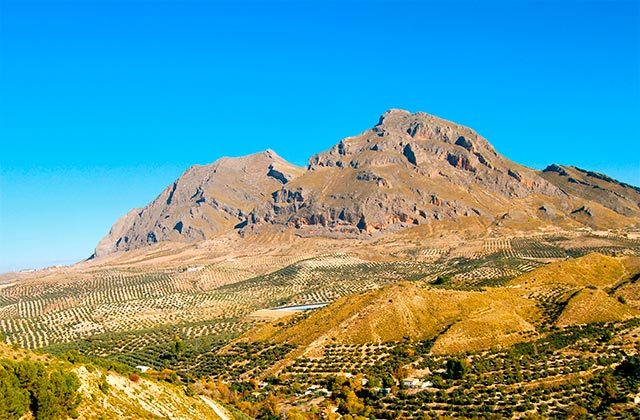
Sierra Mágina natural park
Sierra Mágina is one of the most unknown Andalucia National parks and one of the most beautiful. It is located to the South of the province of Jaén. Here you will find the roof of the province, the Mágina Peak (2,167 meters). Its harsh weather makes it a bit inhabitable for man, which has caused it to be kept in a good preservation state. Surrounded by a sea of olive trees, Sierra Mágina shows the high mountain and well preserved forests of pines, oaks and gall oaks. Golden and Bonelli’s eagles and a few mountain goats can be easily seen in its landscapes. Historically stands out for being the natural border between the Arab and Christian kingdoms, thus, the villages are impregnated with a peculiar medieval atmosphere. If you want to immerse yourself in nature and be far away from the crowd, don’t hesitate, Sierra Mágina is your destination.
17. Sierra de Castril natural park
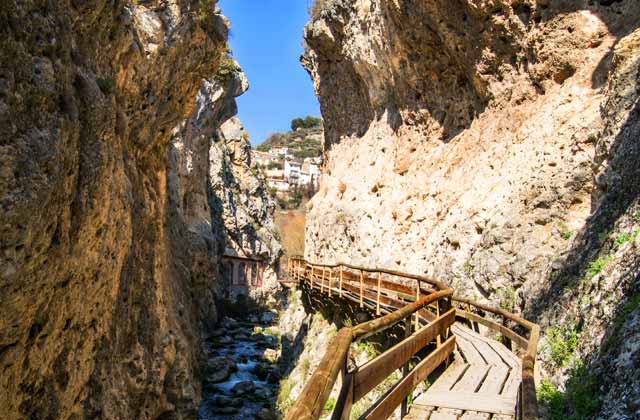
Sierra de Castril, Granada
Castril is another of the great unknown natural wonders. It is located to the northeast of the province of Granada, being part of the Subbetic. The action of the waters and the limestone nature of the soil have favored its incredible wild relief. That is why, in my opinion, Castril has one of the most spectacular landscapes of all the Iberian Peninsula (for example, the birth of the river Castril is a unique site of extreme beauty). The climate in Winter is really hard, with frequent snowfalls. Oaks, maples, gall oaks, pines, savin junipers and brooms are part of the vegetation of Castril. By its steep peaks we can easily see griffon vultures and with a bit of luck, some bearded vultures. The grassland serve as food to livestock of segureña sheep, as well as mountain goat that passes through the mountain.
18. Montes de Málaga

Montes de Málaga
Montes de Málaga, at only five kilometers to the North of the city, are a very rugged relief massif, where we can only find valleys or plains, crossed by a myriad of watercourses, streams, torrents, steep paths and impossible passages.
This natural space occupies the eastern side of the Guadalmedina river basin, a broken massif, mountainous and steep slopes, whose peculiar geological features (waterproof rocks), weather (heavy rain) and an intense human exploitation (vines) were historical cause of the virulent and periodic floods of Malaga. In the first third of the 20th century the final determination was taken to solve this problem through a series of initiatives, like the construction of the regulation reservoir El Agujero, the channeling of the River as it passes through Malaga or the massive reforestation of the space by conifers after the phylloxera finished with the massive planting of vines (1878).
Today it is a splendid pine forest, the lung of Malaga.
19. Sierra de las Nieves
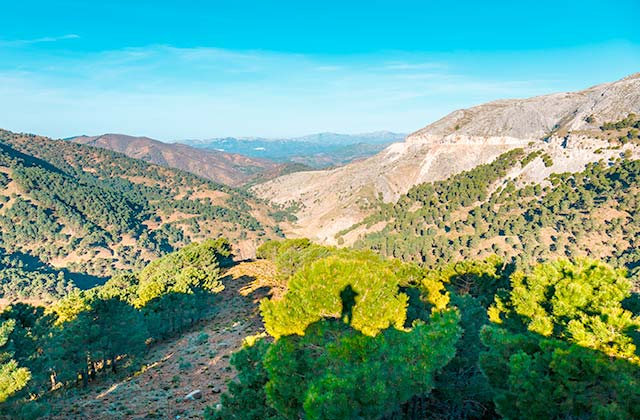
Sierra de las Nieves
In the heart of the province of Malaga, the Sierra de las Nieves is a paradise of contrasts, as shown by the existence of the deepest chasm in Andalucia -GESM- or by its tops that reach 2,000 meters above sea level -La Torrecilla-.
In Malaga and in the western portion of the Baetic Mountains, it is a clear example of the relief’s karstic modeling as underlined by the succession of elevations, cuts, depressions, gorges, siphons, travertines, caves and abysses. The most complex labyrinth of caves and galleries of Andalucia is safely hidden in the Sierra de las Nieves: Sima Honda, Cueva de la Tinaja, Sima del Aire and Sima Prestá. Springs, like the Sulphur water baths of Tolox, complete a scenario where sharp ridges dominate and that covers the largest outcrop of peridotite in the world, rocks of magmatic origin rich in iron, magnesium and heavy metals that in contact with air offer the greenish to brown and reddish tones that characterize the Corona and Abanto hills.
20. Bahía de Cádiz Natural Park
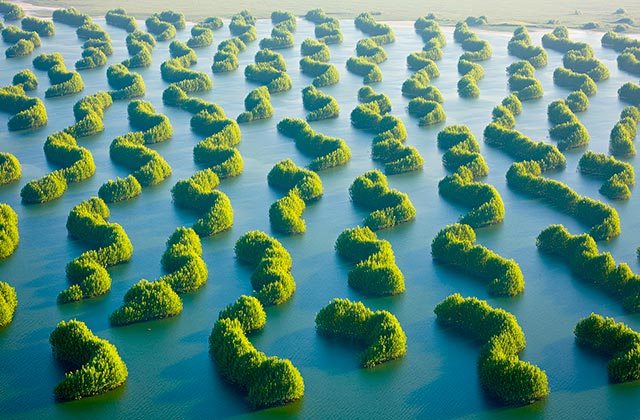
Parque Natural Bahía de Cádiz
Located between the Doñana National Park and the Straits of Gibraltar is the Bahía de Cádiz Natural Park.
The first impression that the Bahía de Cádiz natural park offers is of a complex and cluttered landscape. Nothing could be further from the truth: water, sun, wind and man ride to the beat in a territory that depicts the perfect communion between earth and sea.
To the northeast of the capital, this shallow marine bay, old estuary that received the waters of the rivers Guadalete and San Pedro, occupies a large intertidal area -marshes of the Península de los Toruños, Sancti Petri and Isla del Trocadero- surrounded by a complex system of salt mines -Arillo river-, tributaries -Sancti Petri, Zurraque, Trocadero-, streams and small lagoons. Exceptional beaches, like Levante, Camposoto and La Cachucha-, and more than 3,000 hours of sunshine are the best cover letter of this natural space.
21. Guadalquivir Marshes (Seville)
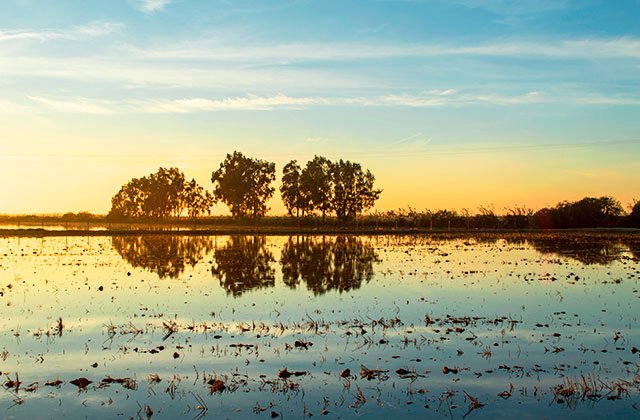
Marismas del Guadalquivir (Sevilla)
The Guadalquivir Marshes are located in the old river estuary, between Seville, Huelva and Cádiz provinces. It covers around 1,243 square miles and they are inside Doñana Natural Park.
Many will know this space for having been immortalised in the film La Isla Mínima, in which the scenes filmed in the Isla Mayor locality stand out. Thanks to this film, this space has become so famous that even the town hall has for some years been offering tours of the adjacent landscapes (Isla Mínima, San Lorenzo del Guadalquivir and San Isidro Canal, among others).
Special mention is made of this area’s gastronomic wealth, and we recommend you visit especially during the Rice Festival and the Crab Festival.
22. Gruta de las Maravillas (Huelva)
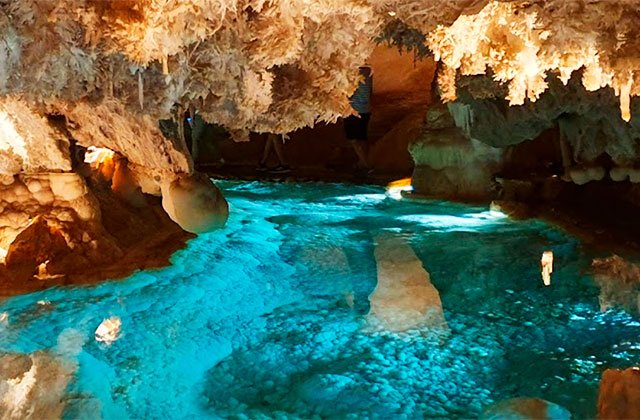
La gruta de las Maravillas (Huelva)
The Gruta de las Maravillas es, as its name indicates, a cave that is located in the Huelvan town of Aracena. The cave stretches over the Cerro del Castillo, on which the Prioral del Castillo Church stands along with the remains of an old fortress. Its entrance is located in the heart of the centre of this locality, more specifically next to San Pedro Square.
Its route is circular and it has different galleries superimposed on three different height levels, where all you can hear is the sound of the water dripping in the middle of an impressive silence. Incredible!
23. Gorafe Desert (Granada)
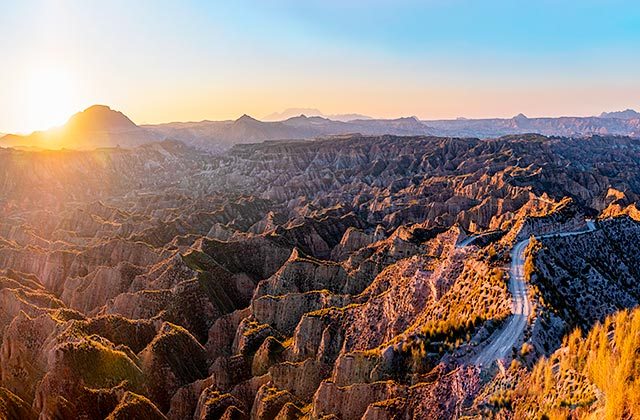
Desierto de Gorafe (Granada)
Los Coloraos y Gorafe Desert is located between the Granadan localities of Gorafe and Villanueva de las Torres, bordering the Negratín Reservoir. We are talking about one of the most beautiful and impressive areas that you will encounter, with views that will remind you of the Grand Canyon. Surrounded by a multitude of extremely interesting points to see and enjoy, this area is one of the great unknowns of Granada in particular and of Andalusia in general.
24. Pulpí Geode (Almería)

La geoda de Pulpí (Almería)
Also called Pilar de Jaravía Geode, it is, as its name indicates, a giant geode of enormous selenite crystals (a transparent variety of gypsum). We can find it between the third and fourth level of the Mina Rica, in Pilar de Jaravía district.
25. Cabo de Gata-Níjar Natural Park (Almería)
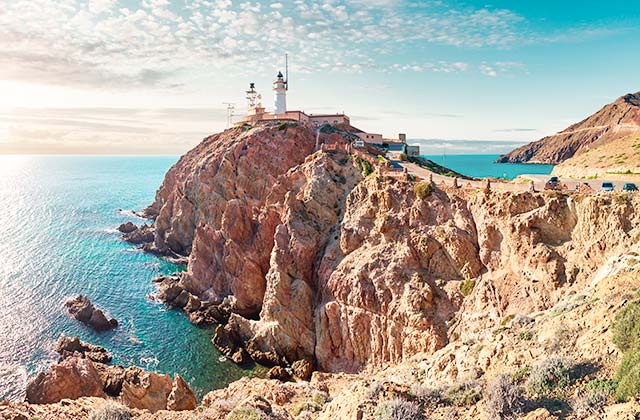
Parque Natural Cabo de Gata-Níjar (Almería)
If you visit Andalusia, you cannot miss this corner of Almería (it was the first protected sea-land space in Andalusia). If you decide to visit, it is practically impossible not to enjoy unforgettable experiences, since between valleys, volcanoes, beaches and gorgeous towns, this visit will remain in a special place in your mind forever. Its heavenly beaches and coves are the best natural remedy for stress.
Practical tips for visiting Parks and Natural Parks of Andalucia
Visiting the natural parks of Andalucia is an unforgettable experience, thanks to their stunning landscape diversity and rich natural heritage. Below, you’ll find some practical tips to make the most of your visit:
- Advance Planning
- Choose the right park: Andalucia is home to numerous natural parks, such as Doñana, Sierra de Grazalema, Cabo de Gata-Níjar, and Sierra Nevada. Research which one best suits your interests (hiking, birdwatching, photography, etc.).
- Check weather conditions: Andalucia has varied weather. In summer, some areas can be extremely hot, while in winter, snow is common in high-altitude regions like Sierra Nevada.
- Schedules and rules: Check the opening hours, allowed areas, and specific regulations for each park. Some parks have protected zones with restricted access.
- Proper Equipment
- Clothing and footwear: Wear comfortable, breathable clothing and sturdy hiking boots or sports shoes with good grip.
- Basic backpack: Pack essentials such as water, sunscreen, a cap or hat, sunglasses, and a light jacket for potential temperature changes.
- Map and GPS: While many trails are marked, having a map or GPS is useful to avoid getting lost.
- Food and Water
- Stay hydrated: Bring enough water, especially during warmer months.
- Snacks: Choose lightweight and nutritious options like energy bars, fruits, or nuts.
- Respect for the Environment
- Leave no trace: Collect all your waste and dispose of it in designated containers.
- Flora and fauna: Observe animals from a distance and avoid picking plants or disturbing their natural habitat.
- Silence: Keep noise levels low to preserve the tranquility and avoid disturbing wildlife.
- Safety
- Hiking in groups: Whenever possible, hike with others. If you go alone, inform someone about your itinerary.
- Know your fitness level: Choose trails that align with your physical ability. Some trails may be challenging.
- Basic first aid kit: Carry items like bandages, disinfectant, pain relievers, and any personal medications you may need.
- Activities and Guided Tours
- Guided tours: Many parks offer guided tours led by local experts, who can provide valuable insights and enhance your experience.
- Photography and observation: Bring binoculars for birdwatching and a camera to capture the breathtaking scenery.
- Best Time to Visit
- Spring and autumn: These seasons are ideal due to moderate weather and the vibrant blooming of flora.
- Winter: Perfect for exploring mountainous areas like Sierra Nevada, especially if you enjoy snow.
- Summer: Avoid hiking during peak heat hours, particularly in arid parks like Cabo de Gata-Níjar.
- Access and Transportation
- Public transport: Some parks, such as Doñana, offer public transportation services or organized excursions.
- Private vehicle: Check access points in advance and determine if a 4×4 vehicle is necessary for reaching remote areas.
- Additional Information
- Visitor centers: Most parks have visitor centers where you can obtain maps, up-to-date information, and helpful advice.
- Mobile applications: Tools like Wikiloc are excellent for efficiently planning your routes.
ACCOMMODATION
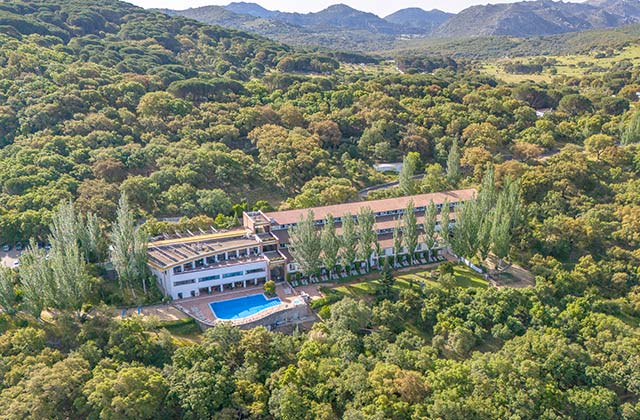
Hotel Fuerte Grazalema
At Fuerte Hoteles, we want to prepare a list of the seven natural wonders of Andalucia together with you. This is the best hotel chain to stay in if you visit southern Spain. The chain has branches where you can enjoy the best of each area throughout Andalucia, in addition to its services. It boasts over 60 years of experience and gives you the time to discover these natural places. Marbella, Conil, Grazalema, El Rompido or Torrox are some areas where you can find incredible accommodation.
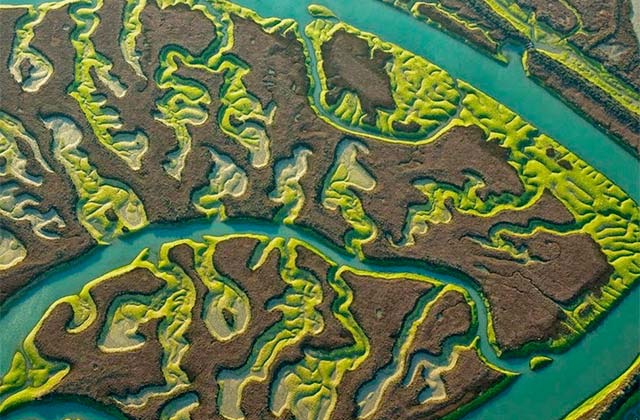
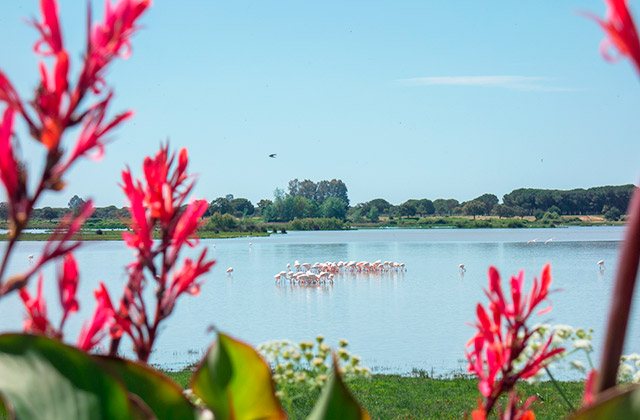
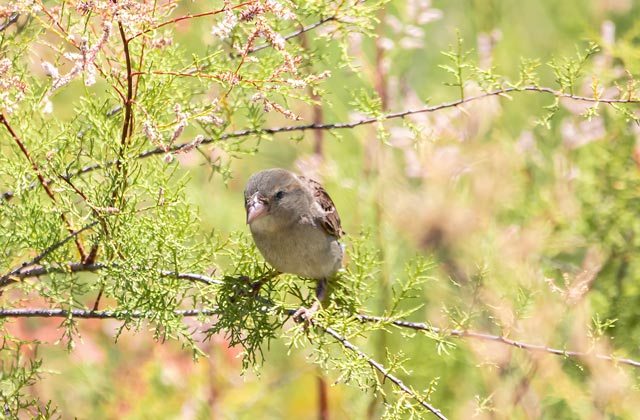










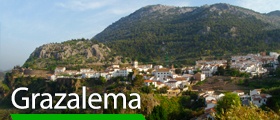






Quite frankly, I have been pondering about visiting Andalucia for a long time because it is truly a magnificent place, but before this moment I hadn’t been really aware of all the places that I can observe there. Undoubtedly, all mentioned wonders of nature captured my heart because each of them has special distinctive features which may not leave anyone indifferent. But my favourite one is El Torcal because it has an incredible history and truly amazing facts which made me delve into learning about this place. I can say that it should be the primary place to visit for all lovers of wild natural landscapes because it fascinates with its bizarre shapes of rocks and stones. I think that El Torcal will also help all visitors to be closer to the history of Andalucia and see it from a different perspective. Of course, it is really important to value all these mentioned places and be able to save them.